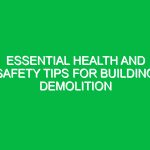Introduction
In the realm of Health, Safety, and Environment (HSE), the term “demolished” holds significant importance, particularly in the context of construction and industrial operations. The demolished definition pertains not only to the physical act of tearing down structures but also encompasses a broader spectrum of implications regarding Safety protocols, environmental considerations, and regulatory compliance. Understanding this concept is vital for professionals in the industry, as it influences planning, execution, and the subsequent management of health and Safety risks. This article aims to explore the critical definition of demolished within the HSE domain, shedding light on its relevance, procedures, potential Hazards, and Best Practices.
Understanding the Demolished Definition
To grasp the full scope of the demolished definition, it is essential to clarify what “demolished” entails in an HSE context. Primarily, it refers to the process of dismantling or destroying a building or structure. This activity is not merely about physical destruction; it involves a systematic approach designed to minimize risks to workers, the public, and the environment. The demolished definition includes various methodologies, from controlled demolitions using explosives to manual dismantling, each necessitating specific Safety Measures and environmental assessments.
Key Aspects of the Demolished Definition in HSE
When examining the demolished definition, several key aspects emerge that are crucial for HSE professionals:
- Planning and Assessment: Before any demolition activity, thorough planning and risk assessment must be conducted. This includes evaluating the structural integrity of the building, identifying hazardous materials (like asbestos), and understanding the surrounding environment.
- Safety Protocols: Implementing robust safety protocols is vital. This involves Training workers on Safe Practices, ensuring the availability of Personal Protective Equipment (PPE), and establishing emergency response plans.
- Environmental Considerations: Demolition can significantly impact the environment. HSE professionals must consider waste management, recycling materials, and mitigating dust and noise pollution.
- Legal Compliance: Adhering to local Regulations and Standards is non-negotiable. Understanding the legal framework surrounding demolition activities ensures that operations are conducted legally and safely.
The Demolition Process: Steps and Best Practices
The demolition process can be intricate and requires adherence to best practices to ensure safety and compliance with HSE standards. Here’s a detailed breakdown of the typical steps involved:
1. Pre-Demolition Planning
The demolition process begins long before any physical work occurs. Conducting a comprehensive site survey allows professionals to identify potential Hazards. This includes assessing the structural integrity and understanding the location’s historical significance. For instance, a site with historical buildings may require additional permits or preservation efforts.
2. Hazard Identification
Identifying hazards is crucial. Common risks include the presence of hazardous materials like asbestos, lead, or chemicals. A thorough assessment ensures that all potential risks are accounted for, allowing for appropriate mitigation strategies.
3. Developing a Demolition Plan
A well-structured demolition plan outlines the methodologies to be used, timelines, and Safety Measures. This plan should also address waste disposal, recycling options, and the management of hazardous materials. Engaging with environmental experts can provide insights into sustainable practices during demolition.
4. Implementation of Safety Measures
Safety measures must be implemented before demolition begins. This includes ensuring that all workers are equipped with PPE, conducting safety drills, and establishing clear communication channels for emergencies. Regular safety meetings can reinforce the importance of following protocols.
5. Execution of Demolition
During the demolition, it’s essential to monitor operations closely. This can involve assigning safety officers to oversee the process and ensure adherence to the established plan. Utilizing advanced technologies, such as drones for site monitoring, can enhance safety and efficiency.
6. Post-Demolition Evaluation
After the demolition is complete, a thorough evaluation is necessary. This includes inspecting the site for any remaining hazards, assessing the effectiveness of the safety measures, and documenting lessons learned for future projects.
Potential Hazards and Risks Associated with Demolition
Demolition activities are fraught with potential hazards, making it imperative for HSE professionals to be vigilant. These risks can broadly be categorized into physical, environmental, and legal hazards:
- Physical Hazards: The most immediate risks include falling debris, equipment accidents, and exposure to hazardous materials. Workers should be trained to recognize these hazards and respond appropriately.
- Environmental Hazards: Dust, noise, and waste can significantly impact the surrounding community. Implementing dust Control Measures and noise reduction strategies is essential for minimizing environmental disruption.
- Legal Hazards: Failure to comply with local regulations can result in fines and legal repercussions. Understanding the legal landscape surrounding demolition activities is crucial for avoiding these pitfalls.
Regulations and Standards Governing Demolition
In the HSE context, several regulations and standards dictate the demolition process. These regulations vary by region but generally share common principles aimed at ensuring worker safety and environmental protection.
1. OSHA Regulations
In the United States, the Occupational Safety and Health Administration (osha) sets forth regulations that govern demolition activities. These regulations require employers to provide a safe work environment, including proper training and PPE for workers.
2. Environmental Protection Agency (EPA) Guidelines
The EPA provides guidelines regarding the management of hazardous waste during demolition. Compliance with these guidelines is essential for protecting both workers and the environment from potential contamination.
3. Local Building Codes
Building codes can vary significantly by location. These codes may dictate specific requirements for permits, structural assessments, and environmental impact assessments. Engaging with local authorities early in the planning process can help navigate these regulations.
Real-Life Examples and Case Studies
Examining real-life examples can provide valuable insights into the practical application of the demolished definition within HSE.
Case Study 1: The Controlled Demolition of a High-Rise Building
In 2019, a high-rise building in a densely populated urban area underwent controlled demolition due to structural instability. The demolition team conducted extensive pre-demolition assessments, identifying asbestos in the building materials. As a result, they implemented a rigorous abatement plan before proceeding with the demolition. The Operation was completed without incident, demonstrating the effectiveness of thorough planning and safety measures.
Case Study 2: Environmental Impact Mitigation in Industrial Demolition
An industrial facility in California faced demolition due to site redevelopment. The project team prioritized environmental considerations by developing a waste management plan that included recycling 75% of the materials from the demolition. Dust suppression measures were implemented using water sprays, and noise barriers reduced disruptions to the surrounding community. This approach not only adhered to HSE regulations but also garnered positive community feedback.
Conclusion
The demolished definition is a critical concept within the HSE domain, encompassing a wide range of factors that impact safety, environmental stewardship, and legal compliance. By understanding the implications of demolition activities, HSE professionals can effectively mitigate risks, ensure worker safety, and protect the environment. The meticulous planning, adherence to regulations, and implementation of safety measures are not just best practices; they are essential components of responsible demolition efforts.
As the industry continues to evolve, ongoing education and awareness of the demolished definition will be vital in promoting health, safety, and environmental Sustainability. Professionals must remain vigilant, adapting to new challenges while prioritizing safety and compliance in their demolition activities. By doing so, they contribute to a safer and more sustainable built environment for future generations.


